
Genoise Sponge Cake
This genoise sponge cake is a super fluffy and spongy cake enriched with butter and egg yolks. It’s a classic recipe that’s used for layer cakes, specifically European style tortes and pastries.
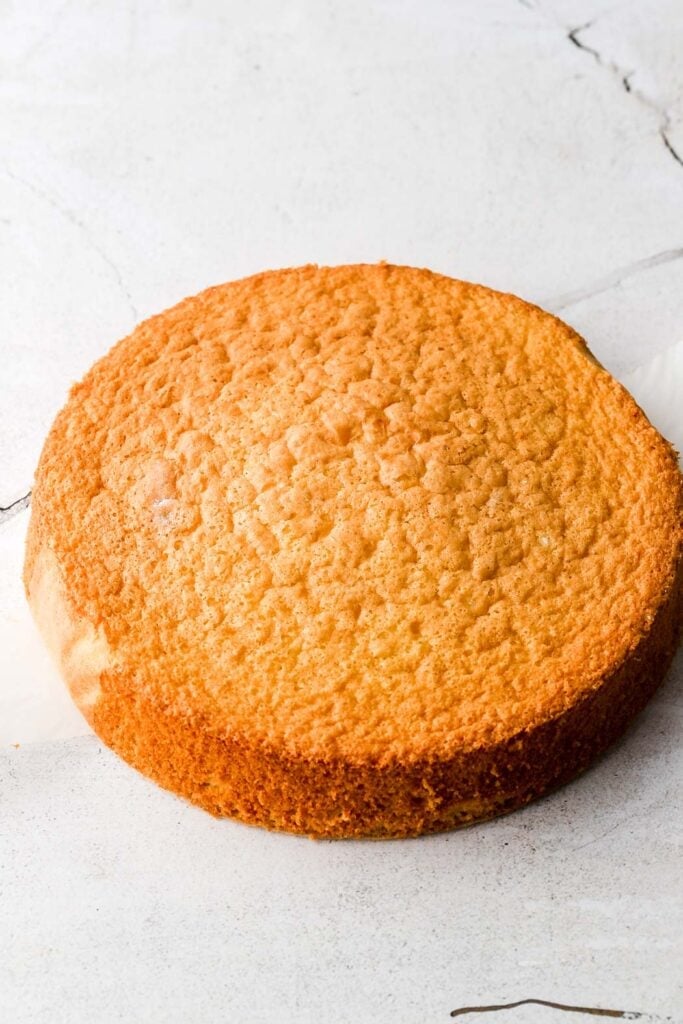
Why you’ll love the recipe
- I promise it’s not as difficult as Paul Hollywood makes it sound.
- It’s super light and fluffy, and so versatile in recipes.
- Can be baked in different size pans, made to different heights, sliced super thin or left as thicker layers.
- Not overly sweet but can be made sweeter with simple syrup.
- Recipe is customizable and works well with dairy free ingredients as well.

What is genoise?
Genoise is one of the most iconic types of sponge cakes. You remember in my book, Frosted, how I introduce you to the type of buttercreams in the beginning of the book and then use those buttercreams in different ways throughout the book?
Well there is a list of base sponge cake recipes, just like that. Of course, everyone makes them a little different but each type of sponge has specific characteristics.
The genoise is light, fluffy and super spongy, just like most types of sponge cakes. The whipped egg whites are what make it super fluffy but the addition of egg yolks and butter are what keep it moist and give it flavor.
For more classic base recipes, make sure to check out my baking basics page.
How to ensure a good rise without chemical leaveners
The genoise sponge is known for the added fat from the egg yolks and butter, but also for the lack of a leavening agent. Unfortunately it’s quite easy to deflate the eggs when mixing in the rest of the ingredients and without baking soda or baking powder, you’ll end up with a flat dense cake if that happens.
So there’s two ways to stabilize the meringue and ensure that it doesn’t deflate completely when adding in the butter and flour.
- The first way is to gently cook the eggs and the sugar over a bain marie (double boiler), whisking until the sugar is fully dissolved or to about 130-140F (54-60C). Then beat it until it’s super thick and the mixture ribbons off the whisk. This usually takes a good 15-20 minutes of beating at full speed.
- The second way, my preferred way, is adapted from the most basic type of sponge the Pan di Spagna or Biscuit Cake. Here the egg whites get beaten with the sugar separately (not traditional for genoise but same ingredients, more consistent results, IMO), until it forms a super fluffy meringue with stiff peaks. This usually takes less than 5 minutes. Then when adding the rest of the ingredients, I continue with the mixer instead of folding by hand and I find that meringue actually deflates a lot less this way and the flour gets mixed in more evenly.
I tested both ways several times (and tested skipping those steps lol) and I prefer the second method, which I use in my prinzregententorte.

Ingredients & Substitutions
- Flour: I use all purpose flour in most of my recipes and I HIGHLY recommend using a digital scale, as flour is so often over measured. Cake flour also works well in this recipe.
- Baking Powder: Genoise is known for not using a leavening agent since it relies on the eggs to lift the cake. HOWEVER, if you’re unsure or have experienced issues with the cake not rising and want a little “insurance” you can definitely use a chemical leavener. For this cake I recommend 2 tsp of baking powder.
- Butter: I like to use salted butter in the cake but unsalted works fine too, just add a little extra pinch of salt. Dairy free butter also works well.
- Sugar: I used granulated sugar in a genoise. I have not tested it with any other type of sugar but I assume a more “wet” sugar would compromise the structure slightly. I don’t recommend reducing the sugar in the cake.
- Eggs: there are A LOT of eggs in the cake. Make sure to use room temperature, large eggs, about 55-60g each.
- Pop them in hot water for a few minutes if they’re cold.
- Unfortunately I have not made this cake without eggs but I know some people have had success with using aquafaba for sponge cakes so try looking up a vegan sponge cake recipe.
- Vanilla: I usually just use a simple vanilla extract in cake batters but I like to use vanilla bean paste for buttercreams and frostings.
Step-by-Step Instructions
Step 1: Start by separating the egg yolks from the whites. Beat the egg whites with the sugar until it’s super thick and fluffy and holds stiff peaks.

Step 2: Add the egg yolks, vanilla and melted butter and beat at medium-high speed until it’s combined, just a few seconds.

Step 3: Sift in the flour and salt and beat at medium-low speed, just until the flour is mixed in. Use a rubber spatula to fold the mixture a couple of times to scrape the edge of the bowl.

Step 4: Distribute the batter evenly among ungreased pans lined with parchment paper, about 10 ounces each, and bake for 20ish minutes. The tops will be golden brown, no longer wet and spring back when you press on them gently.
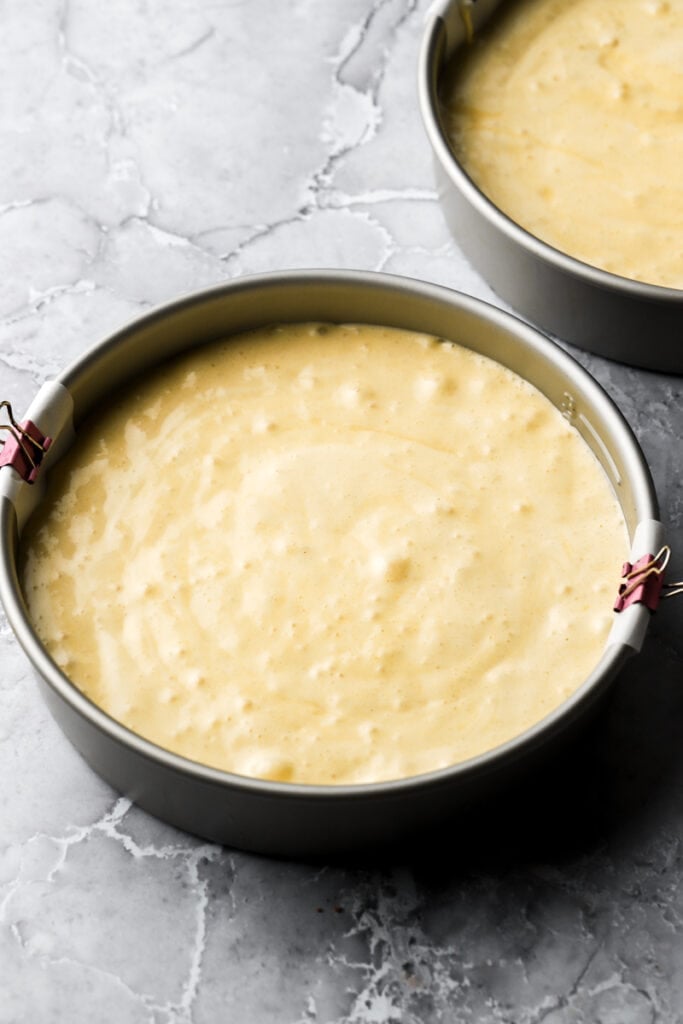
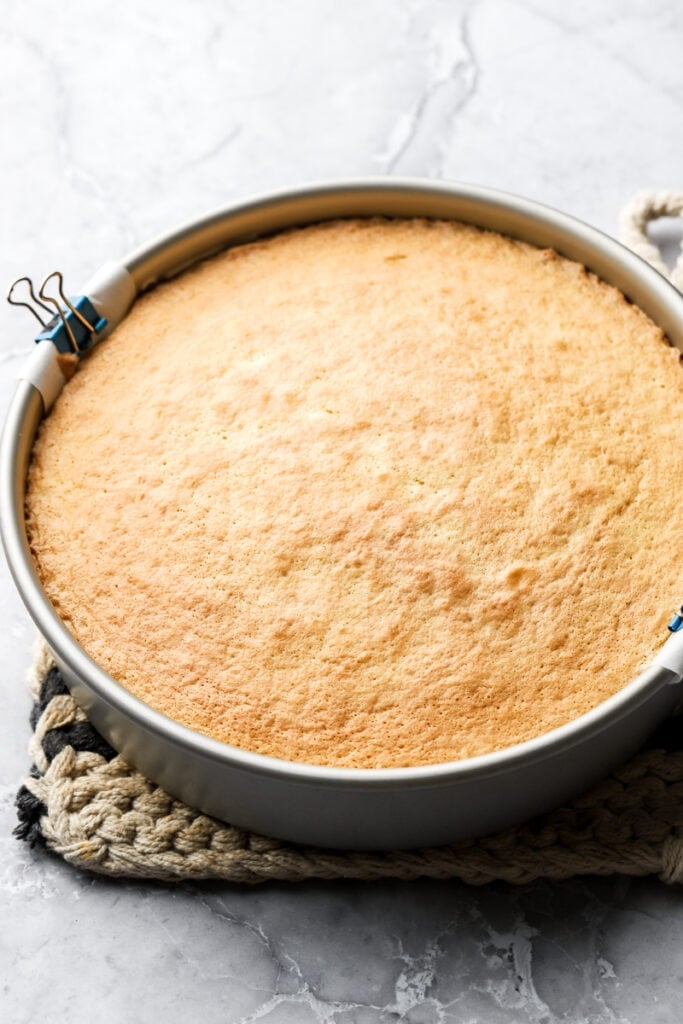
Preparing the cake pan
It’s important not to grease the pan for a genoise sponge. Since the batter is weighed down by the extra fat added and there’s no leavening agent the batter struggles a bit to rise so it clings to the sides of the pan. If you grease the pan, the batter has nothing to “grip” and likely won’t rise.
I also recommend using a regular aluminum or stainless steel pan and not a pan that says “nonstick” as you want the batter to stick to the sides of the pan.
Not greasing it will make it difficult to remove from the pan so I recommend lining the bottom of the pan with a parchment sheet. Then when you remove the cake from the oven, run a knife along the edge to release it from the pan, let it cool for a few minutes and flip it over onto a towel.
What size pan to use
The cake can be baked in:
- Half batch – one layer 8 inch cake; bake for about 18-20 minutes.
- Half batch – one layer 9 inch cake; bake for about 16-19 minutes.
- Full batch – three layer 6 inch cake; about 7-8 oz each and bake for about 14-16 minutes.
- Full batch – two layer 8 inch cake; about 10-11 oz each and bake for about 18-20 minutes.
- Full batch – two layer 9 inch cake; about 10-11 oz each and bake for about 16-19 minutes.
- Full batch – one layer 9×13 inch cake; bake for about 30-40 minutes.
How to know when sponge cakes are done baking
Sponge cakes are fairly easy to assess when they’re done baking. The top will no longer look wet, it’ll have a light golden color, not a dark golden brown color. Then gently press your finger into it and it should have some resistance and/or spring back. If it feels wet underneath the surface or stays indented, leave it a few more minutes.
Try not to open the oven until it’s close to being done though.

Can I flavor the sponge?
You don’t want to mess too much with the sponge itself because it’s quite delicate. You can certainly remove 2 Tbsp of flour and replace it with unsweetened cocoa powder or add 1-3 tsp of any kind of extract or spice (after the eggs are whipped)
That’s about as far as I would take it. I don’t recommend even using any citrus zest because it prevents the eggs from whipping up properly and lowers the pH of the batter, inhibiting its rise. If you do, add it in after the eggs are whipped.
I recommend leaving the rest of the flavoring to the simple syrup and the buttercream/filling.
What type of Frosting to pair with a genoise?
Genoise is one of those cakes that pairs well with any type of buttercream or filling. It’s not too soft and not too firm. My favorite buttercream in general is a whole egg buttercream (download guide below for the recipe) but my favorite for decorating is Swiss Meringue Buttercream.
I also have a French buttercream that would be phenomenal flavorwise but exudes a yellow color and my cookbook, Frosted has a TON more types of frosting.
Traditional American buttercream and cream cheese buttercream also work well but cream cheese may be a little difficult for decorating.
For the amount of cake in the recipe card, a full batch of buttercream (1 cup of butter) would lightly frost it. If you want to decorate the cake as well, I recommend two full batches of buttercream (2 cups of butter).
Feel free to flavor the buttercreams with
- ½ cup unsweetened cocoa powder per batch of buttercream
- ½ cup melted chocolate (any kind) per batch of buttercream
- ½ cup cookie butter/peanut butter/nutella, etc
- ½ cup jam
- 2-4 Tbsp freeze dried fruit
- Any kind of extract

Frequently Asked Questions
You don’t NEED it but it really depends on what you’re making. For my prinzregententorte, I did not use a simple syrup because the cake layers are so thin that the buttercream between all those layers keeps it moist for longer.
For my fraisier cake, I did use a simple syrup because the two layers were slightly thicker. If you want to add extra flavor to the cake, a simple syrup is definitely helpful. Feel free to add vanilla or any extract or to the simple syrup (after it’s removed from the heat).
For example, the coffee soak in my Tiramisu Cake and Opera Cake, the simple syrup in my Cranberry Orange Cake, a lemon simple syrup from my Lemon Poppy Seed Cake, or just a stronger vanilla flavor.
I haven’t tried this yet but I just thought about soaking a genoise with my brown sugar cinnamon syrup and that sounds heavenly.
You can use dairy free butter in a genoise without a problem.
All my cake recipes work well with a 1:1 gluten-free flour like Bob’s Red Mill and King Arthur Flour HOWEVER, I have not tested this with sponge cakes so I am not entirely sure. Please let us know if you do try it!
UPDATE: someone did test it with gluten-free flour and it worked well!
Unfortunately sponge cakes don’t bake up well as cupcakes. They’re flat, more flimsy and oftentimes require a soak which might just make a sad, wet looking cupcake.
How to make ahead
To make the cake ahead of time you can make the cakes even a month in advance. When you remove them from the oven, let them cool for about half an hour and then wrap them individually in plastic wrap. Then place them in a freezer bag, squeezing out all the excess air.
If trimming, slicing in half or soaking the sponge in a syrup, I don’t recommend doing it before freezing. I recommend defrosting the cake a few hours in advance and doing it before assembling.
How to store finished cake
Depending on the type of frosting used with the cake, it may need to be refrigerated. The cake itself can sit out at room temperature but will dry out quicker if it’s not covered or wrapped with plastic wrap.
To freeze a frosted cake, feel free to slice and store in an airtight container. Freeze for 1-2 months and thaw at room temperature a couple hours before serving or thaw in the fridge overnight.
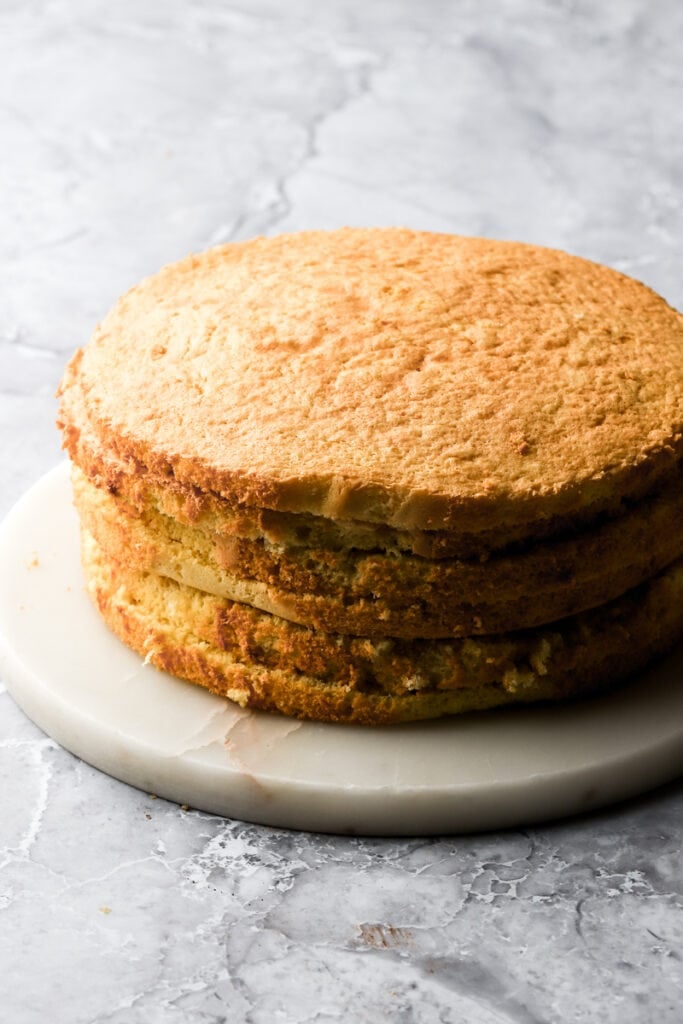
Thanks so much for reading today’s post, if you have any questions just comment down below. Make sure to leave it in the comment section because I can’t answer in the rating section.
If you make this genoise, I’d love it if you left a star rating for me and a comment letting me know what cake you used it in. If it’s less than five stars, please let me know why! 🙂
As always, have a blessed day and happy baking!
Love, B

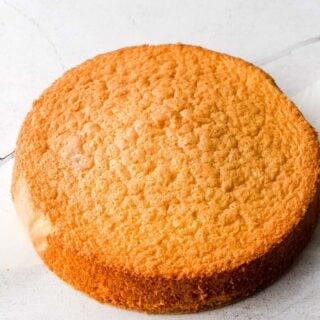
Pay attention to how much batter the recipe says to use per pan, I put all of the batter in two 8 inch pans and it was WAY too much by almost double. By the time it was fully cooked through (40min!) it was dry. Recipe itself is solid though, but could be halved for two 8 inch rounds
You lost me when you said to add the melted butter and egg yolks to the egg whites—won’t the fat ruin the egg whites?
First time and this came out SO well. Absolutely delicious. Incredible rise and the smell of vanilla ! 10/10